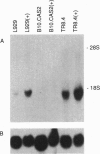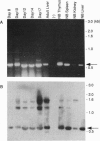Abstract
H-2M3 encodes HMT, the major histocompatibility complex (MHC) class I heavy chain of the maternally transmitted antigen (Mta). Like classical MHC class I genes, the expression of M3 can be stimulated by gamma-interferon and its message can be detected from mid-gestational embryos (day 8) through adulthood. HMTb, a nonimmunogenic allelic form of HMT, differs from the common HMTa molecule by four amino acids, of which only two (residues 31 and 95) are located in the alpha 1 and alpha 2 domains that form the peptide-binding groove. Recognition of site-directed mutants by Mta-specific cytotoxic T lymphocytes was hardly affected by the substitution of Met for Val31 but was abolished by the substitution of Gln for Leu95, which is located in the beta-sheet floor of the peptide-binding groove. Thus a single amino acid difference is responsible for the immunological silence of HMTb.
Full text
PDF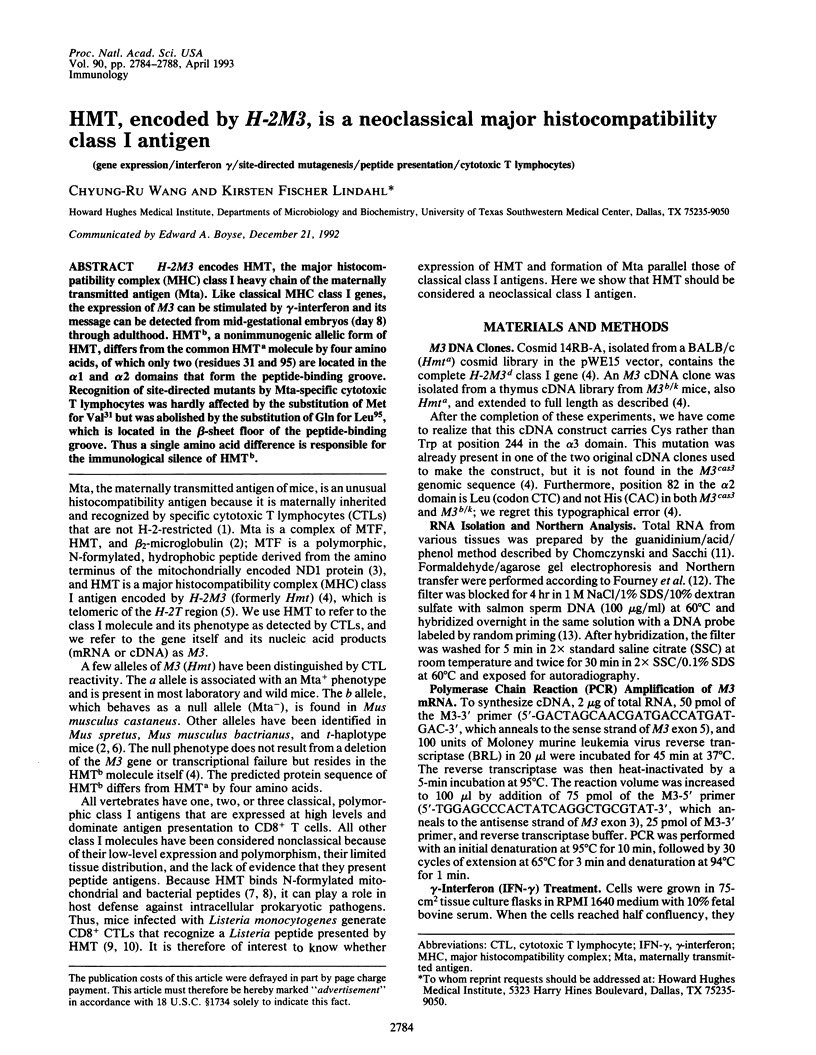
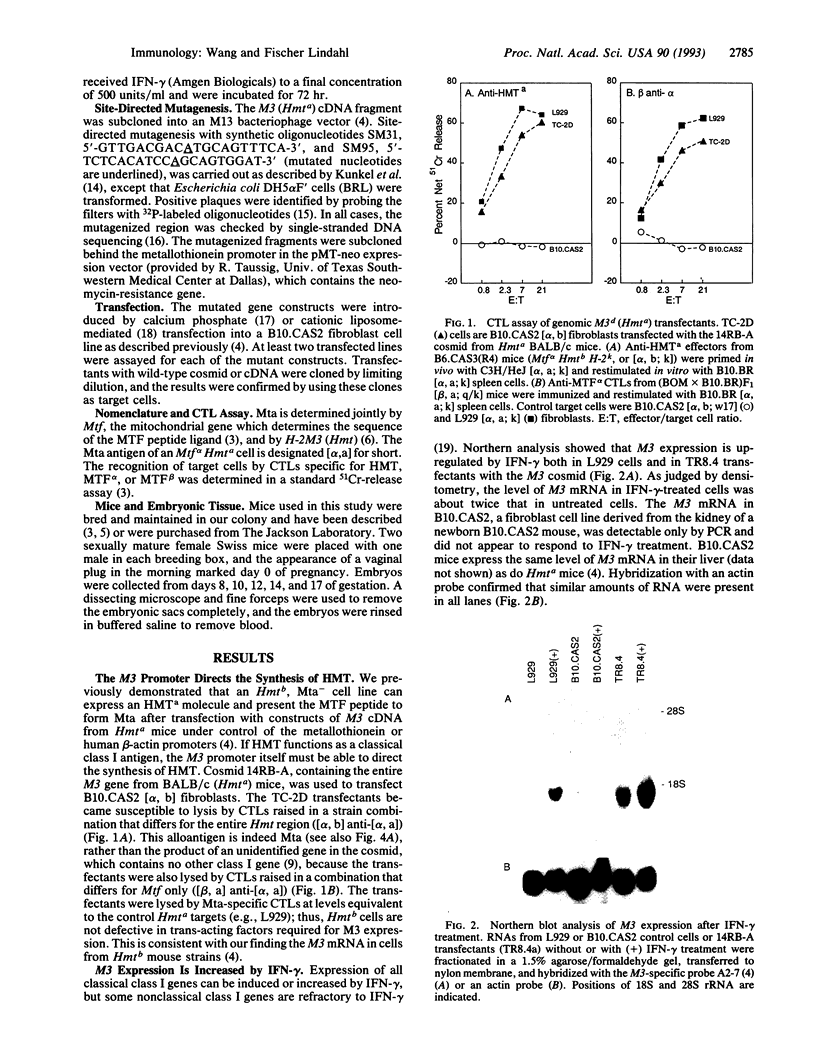
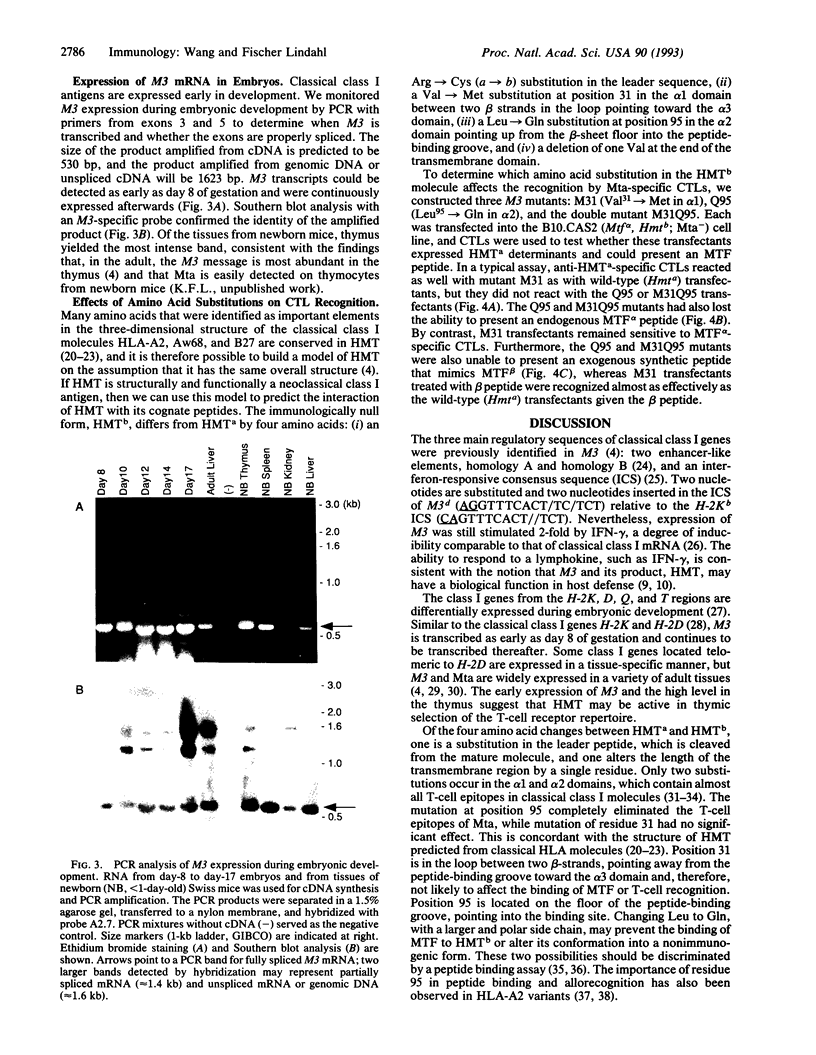
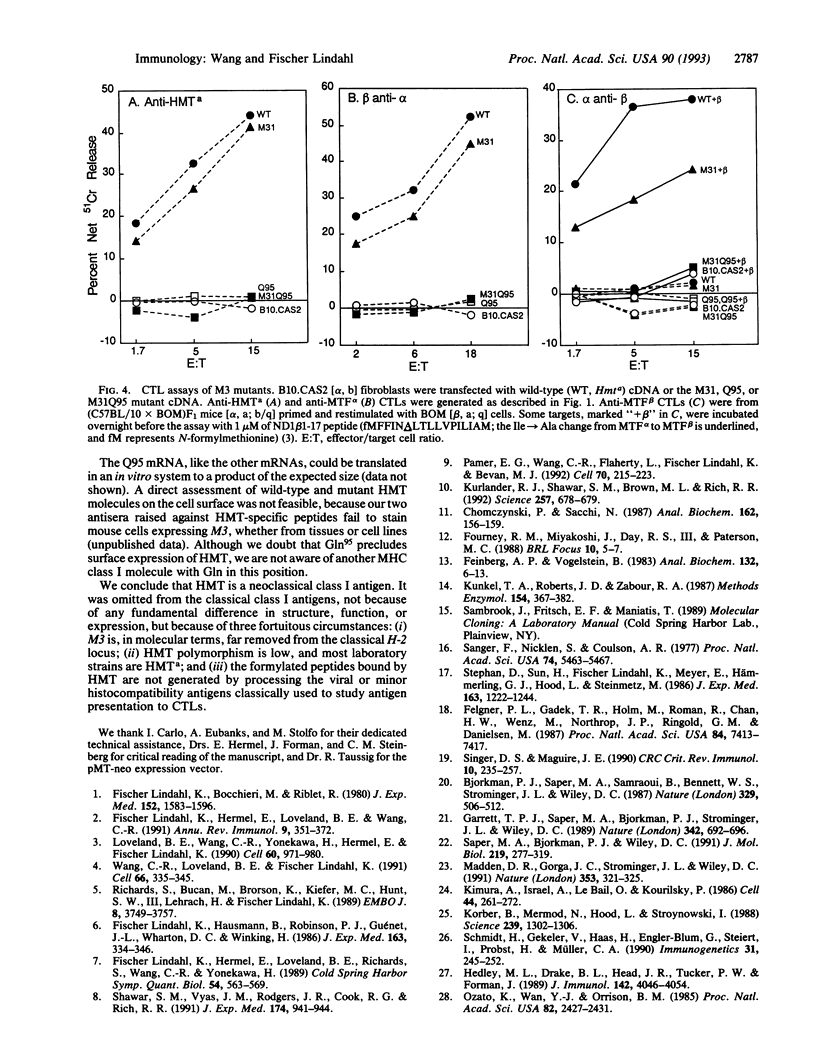
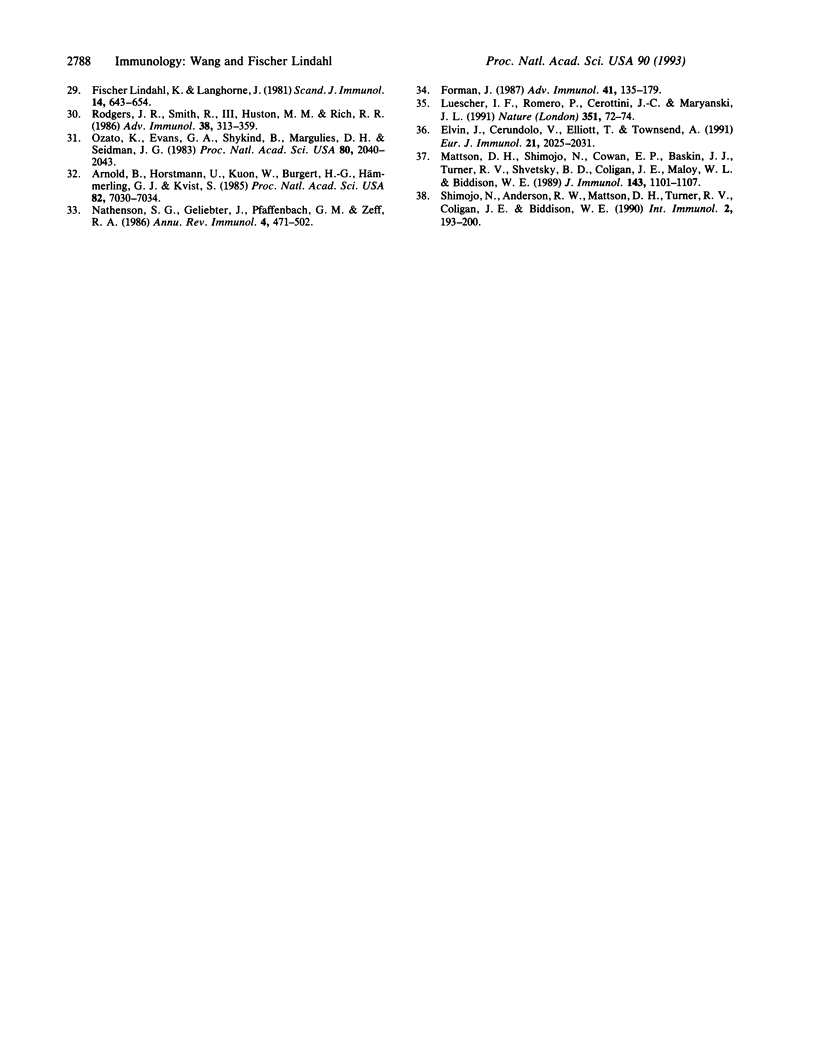
Images in this article
Selected References
These references are in PubMed. This may not be the complete list of references from this article.
- Arnold B., Horstmann U., Kuon W., Burgert H. G., Hämmerling G. J., Kvist S. Alloreactive cytolytic T-cell clones preferentially recognize conformational determinants on histocompatibility antigens: analysis with genetically engineered hybrid antigens. Proc Natl Acad Sci U S A. 1985 Oct;82(20):7030–7034. doi: 10.1073/pnas.82.20.7030. [DOI] [PMC free article] [PubMed] [Google Scholar]
- Bjorkman P. J., Saper M. A., Samraoui B., Bennett W. S., Strominger J. L., Wiley D. C. Structure of the human class I histocompatibility antigen, HLA-A2. Nature. 1987 Oct 8;329(6139):506–512. doi: 10.1038/329506a0. [DOI] [PubMed] [Google Scholar]
- Chomczynski P., Sacchi N. Single-step method of RNA isolation by acid guanidinium thiocyanate-phenol-chloroform extraction. Anal Biochem. 1987 Apr;162(1):156–159. doi: 10.1006/abio.1987.9999. [DOI] [PubMed] [Google Scholar]
- Elvin J., Cerundolo V., Elliott T., Townsend A. A quantitative assay of peptide-dependent class I assembly. Eur J Immunol. 1991 Sep;21(9):2025–2031. doi: 10.1002/eji.1830210909. [DOI] [PubMed] [Google Scholar]
- Feinberg A. P., Vogelstein B. A technique for radiolabeling DNA restriction endonuclease fragments to high specific activity. Anal Biochem. 1983 Jul 1;132(1):6–13. doi: 10.1016/0003-2697(83)90418-9. [DOI] [PubMed] [Google Scholar]
- Felgner P. L., Gadek T. R., Holm M., Roman R., Chan H. W., Wenz M., Northrop J. P., Ringold G. M., Danielsen M. Lipofection: a highly efficient, lipid-mediated DNA-transfection procedure. Proc Natl Acad Sci U S A. 1987 Nov;84(21):7413–7417. doi: 10.1073/pnas.84.21.7413. [DOI] [PMC free article] [PubMed] [Google Scholar]
- Fischer Lindahl K., Bocchieri M., Riblet R. Maternally transmitted target antigen for unrestricted killing by NZB T lymphocytes. J Exp Med. 1980 Dec 1;152(6):1583–1595. doi: 10.1084/jem.152.6.1583. [DOI] [PMC free article] [PubMed] [Google Scholar]
- Fischer Lindahl K., Hermel E., Loveland B. E., Richards S., Wang C. R., Yonekawa H. Molecular definition of a mitochondrially encoded mouse minor histocompatibility antigen. Cold Spring Harb Symp Quant Biol. 1989;54(Pt 1):563–569. doi: 10.1101/sqb.1989.054.01.067. [DOI] [PubMed] [Google Scholar]
- Fischer Lindahl K., Hermel E., Loveland B. E., Wang C. R. Maternally transmitted antigen of mice: a model transplantation antigen. Annu Rev Immunol. 1991;9:351–372. doi: 10.1146/annurev.iy.09.040191.002031. [DOI] [PubMed] [Google Scholar]
- Forman J. Determinants on major histocompatibility complex class I molecules recognized by cytotoxic T lymphocytes. Adv Immunol. 1987;41:135–179. doi: 10.1016/s0065-2776(08)60031-0. [DOI] [PubMed] [Google Scholar]
- Garrett T. P., Saper M. A., Bjorkman P. J., Strominger J. L., Wiley D. C. Specificity pockets for the side chains of peptide antigens in HLA-Aw68. Nature. 1989 Dec 7;342(6250):692–696. doi: 10.1038/342692a0. [DOI] [PubMed] [Google Scholar]
- Hedley M. L., Drake B. L., Head J. R., Tucker P. W., Forman J. Differential expression of the class I MHC genes in the embryo and placenta during midgestational development in the mouse. J Immunol. 1989 Jun 1;142(11):4046–4053. [PubMed] [Google Scholar]
- Kimura A., Israël A., Le Bail O., Kourilsky P. Detailed analysis of the mouse H-2Kb promoter: enhancer-like sequences and their role in the regulation of class I gene expression. Cell. 1986 Jan 31;44(2):261–272. doi: 10.1016/0092-8674(86)90760-9. [DOI] [PubMed] [Google Scholar]
- Korber B., Mermod N., Hood L., Stroynowski I. Regulation of gene expression by interferons: control of H-2 promoter responses. Science. 1988 Mar 11;239(4845):1302–1306. doi: 10.1126/science.3125612. [DOI] [PubMed] [Google Scholar]
- Kunkel T. A., Roberts J. D., Zakour R. A. Rapid and efficient site-specific mutagenesis without phenotypic selection. Methods Enzymol. 1987;154:367–382. doi: 10.1016/0076-6879(87)54085-x. [DOI] [PubMed] [Google Scholar]
- Kurlander R. J., Shawar S. M., Brown M. L., Rich R. R. Specialized role for a murine class I-b MHC molecule in prokaryotic host defenses. Science. 1992 Jul 31;257(5070):678–679. doi: 10.1126/science.1496381. [DOI] [PubMed] [Google Scholar]
- Lindahl K. F., Hausmann B., Robinson P. J., Guénet J. L., Wharton D. C., Winking H. Mta, the maternally transmitted antigen, is determined jointly by the chromosomal Hmt and the extrachromosomal Mtf genes. J Exp Med. 1986 Feb 1;163(2):334–346. doi: 10.1084/jem.163.2.334. [DOI] [PMC free article] [PubMed] [Google Scholar]
- Lindahl K. F., Langhorne J. Medial histocompatibility antigens. Scand J Immunol. 1981 Dec;14(6):643–654. doi: 10.1111/j.1365-3083.1981.tb00607.x. [DOI] [PubMed] [Google Scholar]
- Loveland B., Wang C. R., Yonekawa H., Hermel E., Lindahl K. F. Maternally transmitted histocompatibility antigen of mice: a hydrophobic peptide of a mitochondrially encoded protein. Cell. 1990 Mar 23;60(6):971–980. doi: 10.1016/0092-8674(90)90345-f. [DOI] [PubMed] [Google Scholar]
- Luescher I. F., Romero P., Cerottini J. C., Maryanski J. L. Specific binding of antigenic peptides to cell-associated MHC class I molecules. Nature. 1991 May 2;351(6321):72–74. doi: 10.1038/351072a0. [DOI] [PubMed] [Google Scholar]
- Madden D. R., Gorga J. C., Strominger J. L., Wiley D. C. The structure of HLA-B27 reveals nonamer self-peptides bound in an extended conformation. Nature. 1991 Sep 26;353(6342):321–325. doi: 10.1038/353321a0. [DOI] [PubMed] [Google Scholar]
- Mattson D. H., Shimojo N., Cowan E. P., Baskin J. J., Turner R. V., Shvetsky B. D., Coligan J. E., Maloy W. L., Biddison W. E. Differential effects of amino acid substitutions in the beta-sheet floor and alpha-2 helix of HLA-A2 on recognition by alloreactive viral peptide-specific cytotoxic T lymphocytes. J Immunol. 1989 Aug 15;143(4):1101–1107. [PubMed] [Google Scholar]
- Nathenson S. G., Geliebter J., Pfaffenbach G. M., Zeff R. A. Murine major histocompatibility complex class-I mutants: molecular analysis and structure-function implications. Annu Rev Immunol. 1986;4:471–502. doi: 10.1146/annurev.iy.04.040186.002351. [DOI] [PubMed] [Google Scholar]
- Ozato K., Evans G. A., Shykind B., Margulies D. H., Seidman J. G. Hybrid H-2 histocompatibility gene products assign domains recognized by alloreactive T cells. Proc Natl Acad Sci U S A. 1983 Apr;80(7):2040–2043. doi: 10.1073/pnas.80.7.2040. [DOI] [PMC free article] [PubMed] [Google Scholar]
- Ozato K., Wan Y. J., Orrison B. M. Mouse major histocompatibility class I gene expression begins at midsomite stage and is inducible in earlier-stage embryos by interferon. Proc Natl Acad Sci U S A. 1985 Apr;82(8):2427–2431. doi: 10.1073/pnas.82.8.2427. [DOI] [PMC free article] [PubMed] [Google Scholar]
- Pamer E. G., Wang C. R., Flaherty L., Lindahl K. F., Bevan M. J. H-2M3 presents a Listeria monocytogenes peptide to cytotoxic T lymphocytes. Cell. 1992 Jul 24;70(2):215–223. doi: 10.1016/0092-8674(92)90097-v. [DOI] [PubMed] [Google Scholar]
- Richards S., Bucan M., Brorson K., Kiefer M. C., Hunt S. W., 3rd, Lehrach H., Lindahl K. F. Genetic and molecular mapping of the Hmt region of mouse. EMBO J. 1989 Dec 1;8(12):3749–3757. doi: 10.1002/j.1460-2075.1989.tb08551.x. [DOI] [PMC free article] [PubMed] [Google Scholar]
- Rodgers J. R., Smith R., 3rd, Huston M. M., Rich R. R. Maternally transmitted antigen. Adv Immunol. 1986;38:313–359. doi: 10.1016/s0065-2776(08)60010-3. [DOI] [PubMed] [Google Scholar]
- Sanger F., Nicklen S., Coulson A. R. DNA sequencing with chain-terminating inhibitors. Proc Natl Acad Sci U S A. 1977 Dec;74(12):5463–5467. doi: 10.1073/pnas.74.12.5463. [DOI] [PMC free article] [PubMed] [Google Scholar]
- Saper M. A., Bjorkman P. J., Wiley D. C. Refined structure of the human histocompatibility antigen HLA-A2 at 2.6 A resolution. J Mol Biol. 1991 May 20;219(2):277–319. doi: 10.1016/0022-2836(91)90567-p. [DOI] [PubMed] [Google Scholar]
- Schmidt H., Gekeler V., Haas H., Engler-Blum G., Steiert I., Probst H., Müller C. A. Differential regulation of HLA class I genes by interferon. Immunogenetics. 1990;31(4):245–252. doi: 10.1007/BF00204896. [DOI] [PubMed] [Google Scholar]
- Shawar S. M., Vyas J. M., Rodgers J. R., Cook R. G., Rich R. R. Specialized functions of major histocompatibility complex class I molecules. II. Hmt binds N-formylated peptides of mitochondrial and prokaryotic origin. J Exp Med. 1991 Oct 1;174(4):941–944. doi: 10.1084/jem.174.4.941. [DOI] [PMC free article] [PubMed] [Google Scholar]
- Shimojo N., Anderson R. W., Mattson D. H., Turner R. V., Coligan J. E., Biddison W. E. The kinetics of peptide binding to HLA-A2 and the conformation of the peptide-A2 complex can be determined by amino acid side chains on the floor of the peptide binding groove. Int Immunol. 1990;2(3):193–200. doi: 10.1093/intimm/2.3.193. [DOI] [PubMed] [Google Scholar]
- Singer D. S., Maguire J. E. Regulation of the expression of class I MHC genes. Crit Rev Immunol. 1990;10(3):235–257. [PubMed] [Google Scholar]
- Stephan D., Sun H., Lindahl K. F., Meyer E., Hämmerling G., Hood L., Steinmetz M. Organization and evolution of D region class I genes in the mouse major histocompatibility complex. J Exp Med. 1986 May 1;163(5):1227–1244. doi: 10.1084/jem.163.5.1227. [DOI] [PMC free article] [PubMed] [Google Scholar]
- Wang C. R., Loveland B. E., Lindahl K. F. H-2M3 encodes the MHC class I molecule presenting the maternally transmitted antigen of the mouse. Cell. 1991 Jul 26;66(2):335–345. doi: 10.1016/0092-8674(91)90623-7. [DOI] [PubMed] [Google Scholar]



